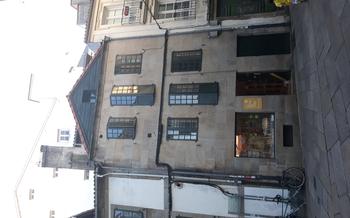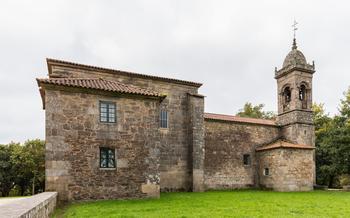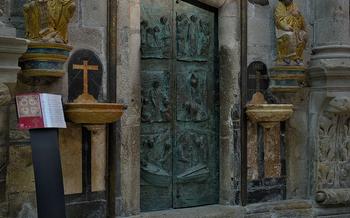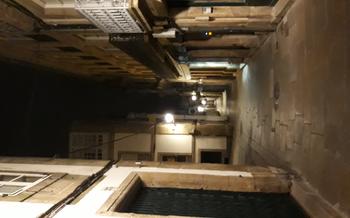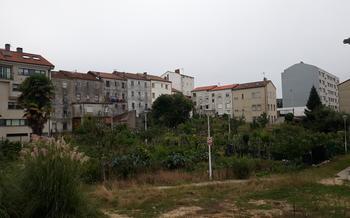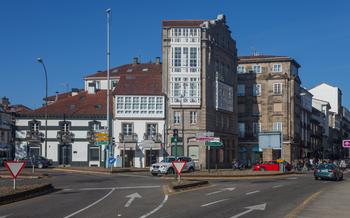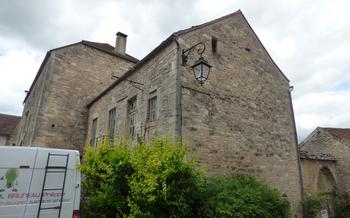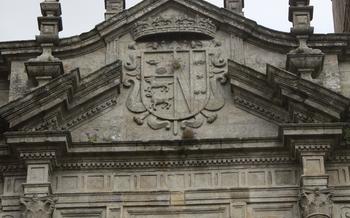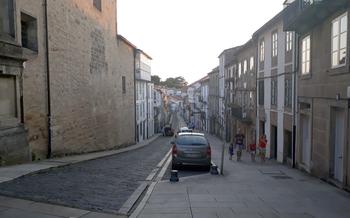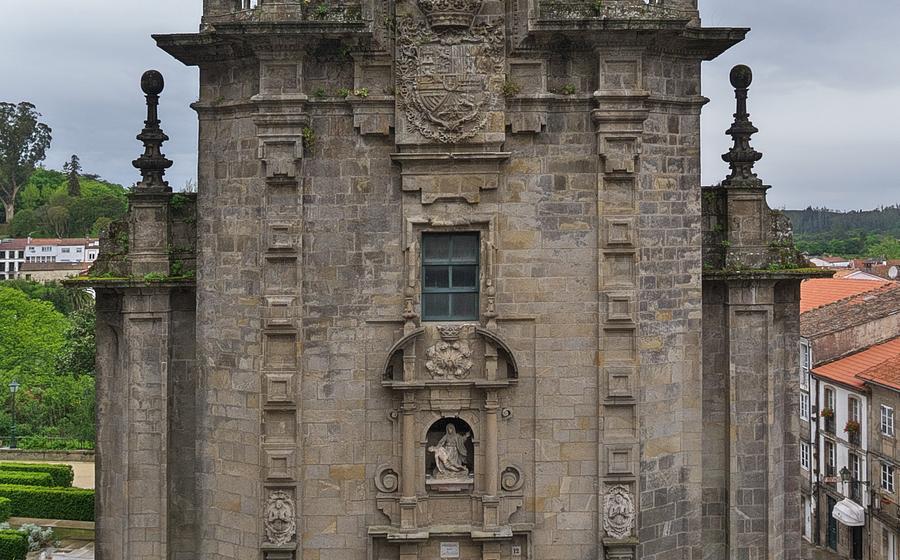
Iglesia de la Angustia Church with Baroque facade
- Iglesia de la Angustia: A Baroque Masterpiece
- Exploring the Intricate Facade
- Stepping Inside the Majestic Interior
- The Story of the Virgin of la Angustia
- Exploring the Neighborhood
- Photography Tips for Capturing the Beauty
- Historical Context of the Baroque Period
- Restoration and Conservation Efforts
- Local Traditions and Customs
- Suggested Tours and Itineraries
- Accessibility and Practical Information
- Cultural and Artistic Significance
- Events and Activities
- Insider Tip: Hidden Gem
Iglesia de la Angustia: A Baroque Masterpiece
Standing as a testament to the grandeur of the Baroque era, the Iglesia de la Angustia is an architectural masterpiece that captivates the hearts of visitors with its ornate facade and awe-inspiring interior. Constructed in the 18th century, this church holds a significant place in the religious and cultural tapestry of Santiago de Compostela.
The church's history is intertwined with the devotion to the Virgin of la Angustia, whose miraculous image is enshrined within its walls. Over the centuries, the church has become a popular pilgrimage site, attracting countless believers seeking solace and spiritual guidance.
The Baroque facade of the church is a symphony of intricate carvings, sculptures, and decorative elements. The central doorway, flanked by towering columns and topped by an elaborate pediment, invites visitors into a realm of artistic splendor.
Inside, the church's majestic interior unfolds, revealing a harmonious blend of architectural styles. The vaulted ceiling, supported by elegant columns, creates a sense of grandeur, while the intricate altarpieces and side chapels showcase the artistry of Galicia's Baroque masters.
Prepare to be captivated by the exquisite works of art that adorn the church's interior. From the lifelike sculptures of saints and angels to the vibrant paintings that depict biblical scenes, each piece contributes to the church's rich visual narrative.
As you explore the Iglesia de la Angustia, let your imagination wander back in time to the era of Baroque opulence. Discover the stories and legends associated with this sacred space, and immerse yourself in the vibrant religious traditions that have shaped the soul of Santiago de Compostela.
Exploring the Intricate Facade
The Baroque facade of the Iglesia de la Angustia is a masterpiece of intricate carvings and sculptural ornamentation. Every inch of the facade tells a story, with symbols, figures, and allegories that reflect the church's history, beliefs, and artistic influences.
The central doorway is particularly impressive, featuring an elaborate architrave adorned with cherubs, garlands, and scrollwork. The tympanum above the door depicts a scene from the Old Testament, with Moses receiving the Ten Commandments from God. The scene is framed by two Solomonic columns, a hallmark of the Galician Baroque style.
The facade's iconography is rich and varied, with symbols representing the virtues, the sacraments, and the life of Christ. The overall effect is one of awe and wonder, inviting visitors to contemplate the mysteries of faith and the glory of God.
The influence of the Galician Baroque style is evident in the facade's dynamic composition, exuberant ornamentation, and use of local granite. The facade is a testament to the skill and artistry of the Galician Baroque masters, who created a unique and enduring work of art.
Stepping Inside the Majestic Interior
The interior of the Iglesia de la Angustia is a testament to the grandeur and opulence of the Baroque style. As you step through the grand entrance, your eyes are immediately drawn to the breathtaking retablo mayor, the main altarpiece that dominates the chancel. This elaborate masterpiece, crafted from intricately carved wood and adorned with gold leaf, depicts scenes from the life of Christ and the Virgin Mary.
The church's transepts are home to several side altars, each dedicated to a different saint or religious figure. Among the most notable is the Capilla de la Virgen de los Dolores, which houses a poignant sculpture of the Virgin Mary grieving over the crucified Christ. The chapel is adorned with beautiful frescoes depicting scenes from the Passion of Christ.
In the nave, the barrel-vaulted ceiling is adorned with stunning frescoes that depict the life of Saint Augustine, the patron saint of the church. The walls are lined with numerous paintings and sculptures, each telling a unique story from the Bible or the lives of the saints.
The Iglesia de la Angustia is not just a place of artistic wonder but also a sacred space for worship and pilgrimage. The church's central location in the historic center of Santiago de Compostela makes it a popular destination for pilgrims on the Camino de Santiago, who come to pay their respects to the Virgin of la Angustia and seek her blessings for their journey.
The Story of the Virgin of la Angustia
The story of the Virgin of la Angustia is deeply entwined with the history and identity of Santiago de Compostela. According to legend, the image of the Virgin was discovered in a field by a shepherdess named Isabel in the 13th century. The shepherdess was guided by a divine dream that led her to the spot where the image was buried.
As news of the miraculous discovery spread, the image was brought to Santiago de Compostela and placed in the Iglesia de la Angustia. Over time, the Virgin of la Angustia became a beloved figure among the local population and pilgrims, who attributed numerous miracles to her intercession.
Among the most famous legends associated with the Virgin is the story of a young man who was unjustly accused of a crime and sentenced to death. He prayed fervently to the Virgin of la Angustia for deliverance, and on the day of his execution, the ropes that bound him miraculously broke. The young man was freed and his innocence was proven, leading to widespread devotion to the Virgin's miraculous powers.
To this day, the Virgin of la Angustia remains a deeply revered figure in Santiago de Compostela. Her annual festivities, held in September, draw thousands of pilgrims and locals who come to pay homage and seek her blessings. The image of the Virgin is carried in a solemn procession through the streets of the city, accompanied by music, dancing, and heartfelt prayers.
Exploring the Neighborhood
The Iglesia de la Angustia is strategically located in the heart of Santiago de Compostela's historic center, making it an ideal starting point for exploring the city's rich cultural heritage. Just steps away, you'll find the majestic Plaza de la Quintana, home to the iconic cathedral and a vibrant square teeming with cafes, restaurants, and shops.
Take a leisurely stroll along the picturesque streets surrounding the church, and you'll stumble upon hidden gems like the Plaza do Obradoiro, the Mercado de Abastos (a bustling traditional market), and the lively Rúa do Franco, known for its charming boutiques and art galleries.
For a deeper dive into the city's history, visit the nearby Museo do Pobo Galego, which showcases Galicia's rich ethnographic heritage. Or, immerse yourself in the city's vibrant art scene at the Centro Galego de Arte Contemporánea, which hosts thought-provoking exhibitions and installations.
After a day of exploration, unwind at one of the many charming cafes or restaurants in the neighborhood. Indulge in traditional Galician cuisine, such as pulpo a la gallega (octopus) or empanada gallega (a savory pastry filled with meat or seafood), while soaking in the vibrant atmosphere of this historic city.
Photography Tips for Capturing the Beauty
The Iglesia de la Angustia offers a feast for the eyes, inviting photography enthusiasts to capture its intricate details and stunning ambiance. To make the most of your photographic adventure, here are some tips to help you capture the church's beauty:
-
Exterior: Position yourself at an angle to capture the full grandeur of the facade. Utilize a wide-angle lens to encompass the entire structure and highlight its symmetry. Experiment with different perspectives, such as shooting from a lower angle to emphasize the imposing nature of the church.
-
Details: Zoom in to capture the intricate carvings and sculptures that adorn the facade. Use a macro lens to reveal the fine details and textures of the stonework. Focus on specific elements, such as the expressive faces of the saints or the delicate floral motifs, to create striking close-up images.
-
Interior: Step inside the church to capture the awe-inspiring atmosphere and intricate details of the interior. Use a tripod to stabilize your camera and avoid blurry images, especially in low-light conditions. Play with different shutter speeds to capture the movement of flickering candles or incense smoke, adding a sense of dynamism to your shots.
-
Equipment: Bring a versatile camera with a wide range of lenses to capture both wide shots of the exterior and close-up details of the interior. A flash or external lighting may be necessary to illuminate the interior effectively, especially in darker areas.
Historical Context of the Baroque Period
The Baroque era in Spain, spanning from the late 16th to the mid-18th century, was a period of artistic and cultural flourishing that left a profound impact on the nation's architecture, painting, and sculpture. During this time, Spain experienced a surge in religious fervor and mysticism, which manifested itself in the construction of grand and ornate churches. The Baroque style, characterized by its dramatic use of light and shadow, intricate ornamentation, and exuberant forms, became the preferred mode of expression for architects and artists.
In Galicia, a distinct regional variation of the Baroque style emerged, known as the Galician Baroque. This style incorporated elements of local traditions and craftsmanship, resulting in a unique blend of architectural forms and decorative motifs. The Galician Baroque style is particularly evident in the churches and monasteries of Santiago de Compostela, a city that played a pivotal role in the region's cultural and religious development.
Notable architects and artists associated with the Baroque movement in Santiago de Compostela include Domingo de Andrade, José de Vega y Verdugo, and Fernando de Casas y Novoa. These masters left their mark on the city's architectural landscape, creating masterpieces such as the Iglesia de la Compañía de Jesús, the Convento de San Martín Pinario, and the Catedral de Santiago de Compostela.
The Iglesia de la Angustia, with its striking Baroque facade, is a prime example of the Galician Baroque style. Its intricate carvings, expressive sculptures, and dynamic composition embody the spirit of this artistic movement. By understanding the historical context of the Baroque period, visitors can gain a deeper appreciation for the church's architectural significance and its role in the cultural heritage of Santiago de Compostela.
Restoration and Conservation Efforts
The Iglesia de la Angustia, like many historical landmarks, has undergone several restoration projects throughout the years to preserve its architectural integrity and artistic value. One of the most significant restorations was carried out in the 19th century, focusing on repairing damage caused by age, weathering, and neglect. During this restoration, the facade was cleaned and repaired, and some of the sculptures were restored or replaced.
In the 20th century, another major restoration project was undertaken to address structural issues and further enhance the church's appearance. This project involved reinforcing the foundations, repairing the roof, and restoring the interior decorations. The church's interior was also cleaned and repainted, and some of the artworks were restored.
Preserving the Iglesia de la Angustia involves ongoing efforts to maintain its architectural integrity and prevent further deterioration. Regular maintenance and inspections are carried out to identify any potential issues, and conservation specialists are consulted to ensure the proper care and preservation of the church's unique features. These efforts help to ensure that this Baroque masterpiece continues to stand as a testament to the city's rich cultural heritage for generations to come.
Local Traditions and Customs
The Iglesia de la Angustia is deeply intertwined with the local traditions and customs of Santiago de Compostela. It serves as a spiritual and cultural hub for the community, hosting various traditional ceremonies and rituals throughout the year. One of the most significant events is the annual Fiesta de la Virgen de la Angustia, held on September 15th. This festival is a vibrant celebration that draws thousands of pilgrims and locals alike.
During the fiesta, the image of the Virgin of la Angustia is carried in a grand procession through the streets of Santiago de Compostela. Devotees offer prayers, flowers, and candles to the Virgin, seeking her blessings and protection. The procession is accompanied by traditional Galician music and dance, creating a festive atmosphere that fills the city's historic center.
In addition to the annual fiesta, the church also plays a central role in local religious traditions. Mass is held daily, and the church is frequently visited by pilgrims and locals seeking solace, guidance, and spiritual renewal. The Virgin of la Angustia is revered as a powerful intercessor, and many people come to the church to pray for her intercession in their personal lives.
The church is also a popular destination for weddings and other religious ceremonies. Its stunning Baroque interior provides a beautiful and sacred setting for these special occasions. The local community takes great pride in the church and its traditions, and it is considered an integral part of the city's cultural heritage.
Suggested Tours and Itineraries
Guided Tours:
-
Official Church Tour: Offered daily by the church docents, providing insights into the history, architecture, and religious significance of the Iglesia de la Angustia.
-
City Walking Tours: Many tour operators offer comprehensive city walks that include a stop at the church, along with other notable landmarks in Santiago de Compostela.
-
Pilgrimage Tours: If you're following the Camino de Santiago, several tour companies organize guided pilgrimages that include a visit to the church, allowing you to delve deeper into its spiritual significance.
Self-Guided Tours:
-
Exterior Exploration: Stroll around the church, admiring its Baroque facade from different angles and capturing its grandeur through photography.
-
Interior Contemplation: Step inside the church during non-service hours to experience its serene atmosphere, marvel at the intricate altars, and contemplate the beautiful works of art.
-
Combined Itineraries: Combine your visit to the church with other nearby attractions like the Cathedral of Santiago de Compostela, the Plaza del Obradoiro, and the Mercado de Abastos, creating a fulfilling itinerary.
Tips for Your Visit:
-
Plan Ahead: Check the church's website or contact the local tourist office for information on guided tours, admission fees, and special events.
-
Time Your Visit: Aim to visit during off-peak hours to avoid crowds and fully appreciate the church's tranquility.
-
Dress Respectfully: Observe the church's dress code by wearing modest clothing that covers your shoulders and knees.
Accessibility and Practical Information
The Iglesia de la Angustia is committed to accessibility and welcomes visitors of all abilities. The church features wheelchair ramps and accessible entrances, ensuring that everyone can enjoy its architectural and artistic treasures. For those seeking further assistance, the church staff is readily available to provide support and guidance.
Admission to the church is free of charge, allowing visitors from all walks of life to experience its beauty and spiritual significance. However, donations are gratefully accepted to support the ongoing maintenance and preservation of this historic landmark.
The Iglesia de la Angustia is open to the public daily, offering ample opportunities for exploration and contemplation. Visitors are advised to check the church's website for any changes in operating hours or special events that may affect their visit.
To enhance your visit, guided tours in various languages are available upon request. These tours provide a deeper understanding of the church's history, architecture, and religious significance. Alternatively, visitors can choose to explore the church at their own pace, using the informative signage provided throughout the interior.
When visiting the Iglesia de la Angustia, it is customary to observe appropriate dress and etiquette. Visitors are encouraged to dress respectfully, covering their shoulders and knees. Photography is permitted within the church, but using flash is prohibited to preserve the artwork and maintain a reverent atmosphere.
For further information or inquiries, visitors can contact the church's office directly or visit their website. The friendly staff is available to assist with any questions or concerns, ensuring a memorable and enriching experience for all visitors.
Cultural and Artistic Significance
The Iglesia de la Angustia stands as a testament to the Galician Baroque architectural style. Its intricate facade, with its profusion of sculptures and decorative elements, exemplifies the region's unique artistic heritage. The church has played a pivotal role in shaping the city's cultural and artistic landscape, serving as a source of inspiration for local artists, architects, and artisans throughout the centuries.
Beyond its architectural significance, the church holds immense cultural and artistic value. It houses a collection of notable artworks, including paintings, sculptures, and religious artifacts, each contributing to the church's rich artistic tapestry. These works showcase the talent and craftsmanship of local artisans and reflect the deep-rooted artistic traditions of the region.
The church's status as a place of pilgrimage has further enhanced its cultural significance. Pilgrims from across the globe have flocked to Santiago de Compostela for centuries, drawn by the allure of the city's sacred sites. The Iglesia de la Angustia has become an integral part of this pilgrimage route, offering pilgrims a place of respite, reflection, and spiritual connection.
In recognition of its exceptional cultural and historical value, the church has received numerous accolades and distinctions. It has been declared a Bien de Interés Cultural (Asset of Cultural Interest) by the Spanish government, a testament to its national significance. The church's inclusion on this prestigious list underscores its importance as a cultural heritage site and ensures its preservation for future generations.
Events and Activities
The Iglesia de la Angustia is not just a place of worship but also a vibrant cultural hub that hosts a variety of events and activities throughout the year. Music lovers can delight in concerts held within the church's hallowed halls, where the acoustics create a truly immersive experience. Art enthusiasts can admire exhibitions showcasing the works of local and international artists, whose creations often draw inspiration from the church's rich history and symbolism.
For those seeking a deeper connection with the local community, volunteering opportunities are available, allowing visitors to contribute to the preservation and maintenance of this beloved landmark. Participating in community initiatives organized by the church is another meaningful way to engage with the people of Santiago de Compostela and learn about their traditions and beliefs.
Whether you're a pilgrim, an art aficionado, or simply someone seeking a unique and enriching experience, the Iglesia de la Angustia offers a multitude of ways to immerse yourself in its sacred atmosphere and vibrant cultural offerings. Embrace the opportunity to connect with the local community, discover hidden treasures, and create lasting memories within the walls of this magnificent Baroque masterpiece.
Insider Tip: Hidden Gem
Amidst the grandeur of the Iglesia de la Angustia, there lies a hidden gem that often goes unnoticed by visitors. As you explore the church's interior, take a moment to seek out the small, unassuming chapel dedicated to the Virgen de la Soledad (Our Lady of Solitude). Tucked away in a corner, this chapel houses a beautiful and poignant statue of the Virgin Mary, depicted in her solitary state as she grieves the crucifixion of her son. The statue, with its intricate details and serene expression, is a masterpiece of religious art and a testament to the skill of Galician craftsmen. Discover this hidden treasure and experience a moment of tranquility and reflection within the bustling church.
To fully appreciate the beauty of this hidden gem, visit the church during a quiet moment, perhaps early in the morning or late in the afternoon, when the crowds are fewer. This will allow you toじっくりとobserve the statue and soak in its serene atmosphere without distractions. Remember to maintain a respectful demeanor and follow any guidelines or protocols established by the church for visiting the chapel.
